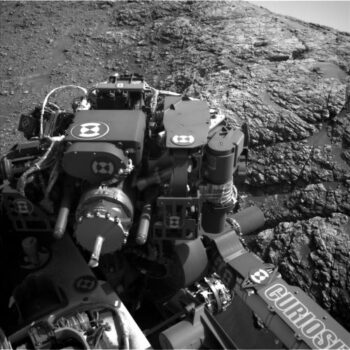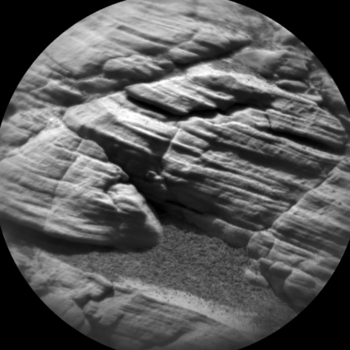
Curiosity Left B Navigation Camera photo taken on Sol 2924, October 27, 2020.
Credit: NASA/JPL-Caltech
NASA’s Curiosity Mars rover is now performing Sol 2925 tasks.
The rover’s short drive – also called a “bump” – on Sol 2924 went well, reports Ken Herkenhoff, a planetary geologist at the USGS Astrogeology Science Center in Flagstaff, Arizona. The robot is now on a relatively steep slope right next to the “Maybole” outcrop.

Curiosity Left B Navigation Camera photo taken on Sol 2924, October 27, 2020.
Credit: NASA/JPL-Caltech
“Every time we prepare to deploy [Curiosity’s] arm, the risk of the wheels slipping due to the change in the vehicle’s center of gravity must be assessed,” Herkenhoff explains. A recent assessment was more difficult than usual, he adds, because of the roughly 26-degree rover tilt and the proximity of the outcrop, making it a challenging day for the tactical team.

Curiosity Right B Navigation Camera image acquired on Sol 2924, October 27, 2020.
Credit: NASA/JPL-Caltech
“But ultimately we got the ‘go’ from the experts assessing the slip risk, and we did not have to remove any arm activities from the plan,” Herkenhoff points out.
Brief nap
Before the arm will be deployed on Sol 2925, Navcam will search for dust devils and Mastcam and Navcam will measure the opacity of dust in the atmosphere.
Then Curiosity’s Chemistry and Camera (ChemCam) will measure the elemental chemistry of targets dubbed “Bister” and “Fittie” and the Right Mastcam will take documentary images of both ChemCam targets.
Mastcam will then acquire a 3 x 1 stereo mosaic of a small crater named “Crubba” before the rover takes a brief nap.

Curiosity Chemistry & Camera Remote Micro-Imager (RMI) photo taken on Sol 2924, October 27, 2020.
Credit: NASA/JPL-Caltech/LANL
Drill sample measurements
Later in the afternoon, a new plan calls for the Mars Hand Lens Imager (MAHLI) to acquire a full suite of images of the outcrop target “Bablin” before the Alpha Particle X-Ray Spectrometer (APXS) is placed near that target for a short evening integration.
APXS will then be placed directly on the Bablin target for a long, overnight integration, during which the rover’s Chemistry & Mineralogy X-Ray Diffraction/X-Ray Fluorescence Instrument (CheMin) will return data from its most recent measurement of the “Groken” drill sample, Herkenhoff concludes.


